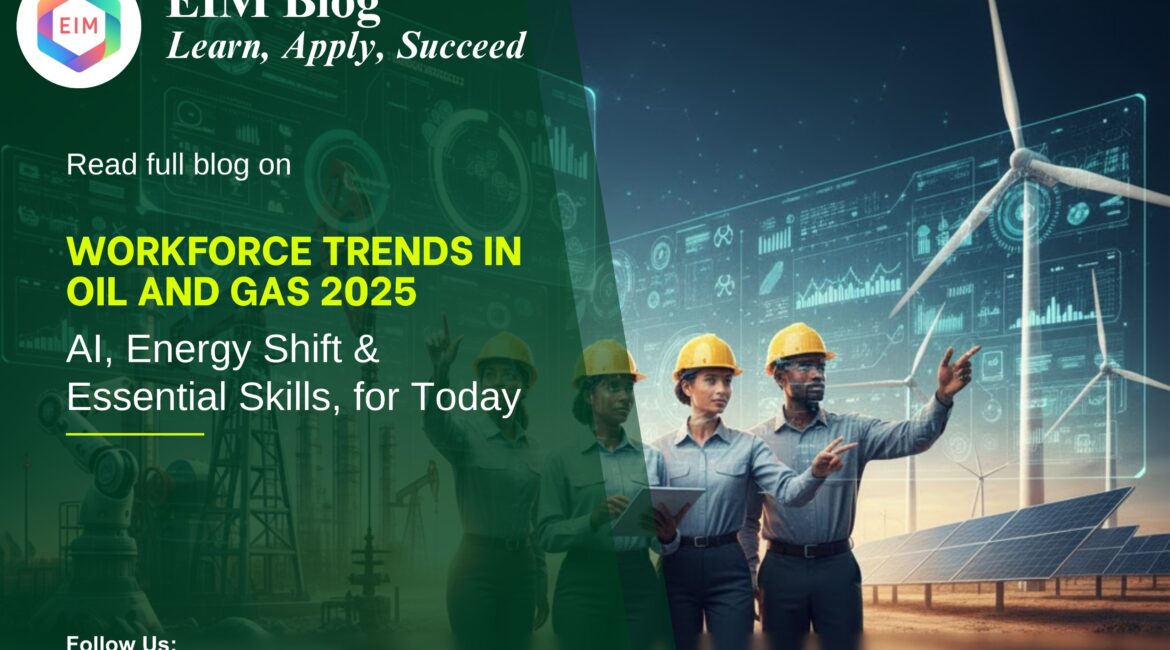
Workforce Trends in Oil and Gas 2025: AI, Energy Shift & Essential Skills, for Today
The oil & gas sector is in a period of fast, sometimes turbulent change. In 2025, companies face a unique mix of pressures — from decarbonization targets and geopolitical shifts to rapid digitalization and shifting labor markets. These forces aren’t just changing strategy and capital allocation; they’re transforming the people side of the business: who is hired, how work gets done, and what skills matter. This long-form guide breaks down the most important workforce trends shaping oil & gas in 2025, explains why they matter, and gives practical guidance for employers, HR leaders, and workers who want to stay ahead.
1. AI, automation and the rise of “smart” operations
AI, machine learning, and advanced analytics moved from pilot projects to core operations in 2025. Companies use predictive maintenance to reduce downtime, computer vision to inspect assets remotely, and AI-driven optimization to squeeze more efficiency from reservoirs and refineries. That shift changes the workforce mix: fewer roles focused on manual monitoring, more roles for data engineers, ML specialists, and “AI-enabled” field technicians who can interpret model outputs and translate them into operational decisions. Evidence from industry analyses shows firms embracing AI-first strategies to accelerate operations and cost savings.
What this means in practice
-
Routine monitoring and first-level diagnostics become automated.
-
Human roles shift toward oversight, exception handling, and continuous model improvement.
-
Job descriptions increasingly list data literacy, Python/SQL basics, and experience with cloud/edge computing as “nice-to-have” or mandatory skills.
2. Digital transformation — more than technology, it’s an operating model
Digital investment (IoT, cloud, edge computing, mobile-enabled field tools) continues to grow rapidly. Market forecasts point to a sizeable digital transformation market in oil and gas over the coming years, and companies are restructuring to embed digital into core business units rather than leaving it to a centralized “innovation” team. That organizational change requires new talent pipelines and blended skill sets (operations + software + data).
Actionable HR moves
-
Create cross-functional “product” teams pairing operators, data scientists and software engineers.
-
Offer rotational programs so field staff can gain hands-on exposure to digital tools.
-
Hire digital translators — people who can convert operational problems into data problems and vice versa.
3. Energy transition & decarbonization reshape roles and location of jobs
Decarbonization policies, investor pressure, and corporate net-zero commitments are shifting capital toward renewables, hydrogen, carbon capture, and low-emissions fuels. That creates both risk and opportunity: some hydrocarbon roles will shrink while demand grows for engineers and technicians with expertise in CCS, hydrogen, electrification, and emissions monitoring. Strategic workforce planning must account for redeployment pathways and new competency models. Global energy outlooks emphasize the lasting effect of the transition on human capital and investment flows.
Employer recommendations
-
Map existing roles against future “green” roles to identify transferable skills.
-
Run targeted retraining for experienced technicians (e.g., instrumentation for carbon-capture systems).
-
Collaborate with local governments and training providers to safeguard regional employment impacted by site closures or project cancellations.
4. Talent shortage, aging workforce and the competition for early-career hires
Many regions still face a twin challenge: an aging cohort of experienced staff approaching retirement and difficulty attracting Gen Z and younger talent who may prefer greener industries or tech-first careers. Industry bodies have documented recruitment gaps and the need to make oil & gas careers more attractive through clearer upskilling pathways, safety credentials, and storytelling about career variety.
How to attract younger talent
-
Promote transferable, future-facing career paths (e.g., data engineering in upstream, hydrogen operations).
-
Offer flexible work options and meaningful upskilling budgets.
-
Highlight safety culture, international mobility, and the role employees play in the energy transition.
5. Remote operations, digital twins and distributed teams
Remote operations centers, digital twins, and centralized control rooms enabled by secure connectivity are changing where work happens. More planning, monitoring, and even troubleshooting can be done from centralized hubs or home-based workplaces, which expands the potential talent pool but introduces new management and cybersecurity challenges. These operational models favor employees who are comfortable with remote collaboration tools and asynchronous communication.
Best practices
-
Invest in human-centered design for remote tools — minimize alert fatigue and improve decision support.
-
Train supervisors in leading distributed teams and measuring productivity by outcomes rather than “seat time.”
-
Harden cyber hygiene training; remote operations broaden the attack surface.
6. Reskilling and lifelong learning as business imperatives
With rapid tech adoption and shifting business models, one-off training is inadequate. Companies that invest in continuous learning — micro-credentials, bootcamps, hands-on digital labs, and partnerships with universities — will have a strategic advantage. Global workforce reports emphasize the urgent need for reskilling programs that help workers transition from legacy roles toward digital and low-emission competencies.
Program ideas that work
-
Short, competency-based certificates focused on cloud fundamentals, data analytics, and digital maintenance.
-
Apprenticeships that combine field rotations with classroom learning in new energy tech (CCS, hydrogen).
-
Incentivized internal mobility programs — clear career ladders and financial support for certification.
7. Evolving safety culture and human factors engineering
Automation reduces exposure to hazardous tasks, but it introduces new human factors risks: overreliance on automation, alert fatigue, and skills atrophy for manual tasks. Safety programs now embed human factors engineering, scenario-based simulations using digital twins, and stronger crew resource management training to ensure that operators can step in effectively when systems fail.
Safety actions
-
Use simulator-based drills paired with AI-driven scenario generation.
-
Rotate personnel through both automated and manual operations to keep skills sharp.
-
Maintain robust incident capture and learning systems that include close-loop feedback to training teams.
8. Compensation, flexible work and changing benefits expectations
As competition for digital and technical talent increases, compensation packages are evolving. Beyond base pay, candidates — especially younger ones — look for flexible work, remote options, career development budgets, and benefits that support wellbeing and family life. Employers who modernize reward systems and emphasize skills-based pay structures find it easier to both attract and retain talent.
9. The role of partnerships: industry, academia, and governments
No single company can scale the reskilling or infrastructure needed for the energy transition alone. Strategic partnerships — industry consortia for shared training centers, university workforce pipelines, public support for regional transition funds — are becoming commonplace. These collaborations help standardize credentials and reduce friction in moving workers between sectors (e.g., from oil & gas to offshore wind or hydrogen projects).
10. Ethical, diversity and governance considerations
Workforce transformation must be inclusive. Companies are increasingly accountable to investors and communities for fair transition practices: protecting livelihoods, offering retraining, and ensuring local hiring where possible. Improving diversity — gender, ethnic, cognitive — is also an operational priority; diverse teams have been shown to produce better technical and safety outcomes.
Practical checklist for HR & operations leaders (quick wins)
-
Audit skills now — identify critical roles at risk and those needed in 3–5 years.
-
Launch microlearning — roll out short, role-specific training for digital tools.
-
Create hybrid job families — blend operations and tech competencies into new career paths.
-
Partner locally — collaborate with vocational institutes and universities for fast-track talent.
-
Measure outcomes — track internal mobility rates, time-to-fill for new roles, and reskilling ROI.
Advice for professionals and job seekers
-
Learn the language of data: basic SQL, Excel for analytics, and familiarity with digital twins and cloud services will open doors.
-
Get certified: short, recognized industry certificates (safety, instrumentation, data analytics) accelerate transitions.
-
Embrace continuous learning: seek rotational assignments, mentoring, and hands-on digital projects.
-
Tell your story: emphasize transferable experience (troubleshooting, safety leadership, project delivery) when moving into greener or digital roles.
Conclusion — the human equation still decides outcomes
Technology and policy will reshape the oil & gas workforce in 2025, but success hinges on people. Organizations that treat workforce transformation as strategic — with clear reskilling investments, inclusive transition plans, and modern talent practices — will be more resilient and competitive. For workers, adaptability, continuous learning, and comfort with hybrid tech–operations roles will be the biggest assets






